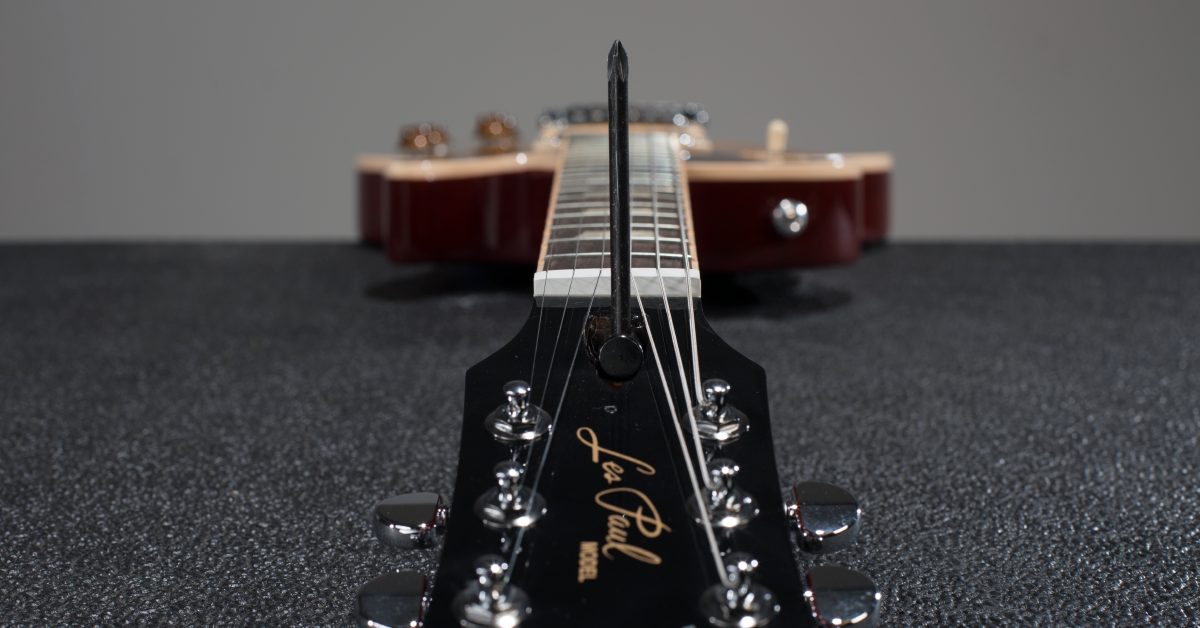How To Set Up Your Electric Guitar Part 1: Adjusting the Truss Rod

In this three-part series, we’ll discuss everything you’ll need to know to start doing professional-grade setups at home. Each article will focus on a different part of the setup process (Relief, Action, and Intonation) and we’ll include links to related articles, more in-depth explanations, and tons of tips and tricks we’ve learned over the years. Setting up your own guitar can seem daunting at first, but this series will get you the know-how you’ll need to make your setups just as accurate as the pros.
In this article, we will show you how to adjust the truss rod in your guitar properly. This process can be broken down into five steps:
- How does a truss rod work?
- Setting up your guitar shop workspace
- How to sight a guitar neck
- How to do the tap test
- How to properly adjust the truss rod
- Check for fret buzz
Adjusting relief, action, and intonation is the groundwork for getting the dream playability out of your guitar.
How does a truss rod work?
A truss rod is a metal bar (usually made from steel or graphite) that reinforces the neck of a guitar, bass, or other stringed instruments. When tuned up to pitch, the strings will put several hundred pounds of pressure on the neck –more than enough to bend it. A truss rod’s job is to counteract that tension and allow the player to adjust how much (or how little) the neck bows.
There are two kinds of truss rods: single action and dual-action. A single-action truss rod is only threaded on one end, but dual-action truss rods are threaded on both ends. Threading both ends allows the truss rod to increase or decrease neck relief before running out of adjustment. Adjusting the threads on the end of a truss rod counteracts the tension of the strings and will increase or decrease the distance between the strings and the frets depending on which way you turn it.
Setting up your guitar workspace
Before you begin, you’ll want to ensure you have all the necessary tools and enough space to do a safe and accurate setup. While a mat or padded workbench is preferred, simple solutions such as a blanket, towel, and pillow will work just as well. However, if you are not sure of the proper tool or wrench size, consult your Owner’s Manual or contact the manufacturer to avoid the risk of damaging your instrument.
The list below is a great reference, but don’t forget the most important tools of all; your eyes and ears.
Tools you’ll need
- Phillips/ Large Flathead Screwdriver or Spanner Wrench
- Properly sized Allen wrenches or socket wrench for truss rod
- 6” Ruler graduated in 1/32” and 1/64” increments.
- Electronic Tuner
Optional tools
How to sight a guitar neck
The first step in any setup is to look at the neck and see what correction we may need to make. By sighting the neck, we understand how the neck reacts to the string tension and truss rod relief. At this point, we’re just trying to get an understanding of whether the neck is straight or not.
- Tune the guitar to pitch.
- Turn the guitar on its side, close one eye, and look down the neck from the headstock towards the bridge (left).
- Look down the profile of the fretboard on both the bass and treble sides of the neck. Is the neck straight, or is there a curve?
- Because the truss rod will affect the middle of the neck most, be sure to pay special attention to upbow or backbow in the area between the 3rd and 9th fret.
Upbow & Backbow
If this is the first time you’ve ever tried to sight your instrument’s neck, you may be a little unsure of what to look for. If your guitar’s neck is not straight, it is likely to have either upbow or backbow. While upbow will cause the string to be too far from the frets and impede playability, backbow will move them too close and produce fret buzz.
Looking down the neck will help you determine if the neck is straight or bowed.
How to do the tap test
Don’t be discouraged if you can’t sight the neck right away; it takes some practice. Another method for assessing the neck’s playability is the Tap Test. The Tap Test is an easy way to “feel” the amount of neck relief by using the string as a straight edge.
The space between the string and frets will reflect the bow of the neck. If there is too little space, it is likely the neck suffers from backbow. If there is too much space, the neck has upbow, or too much relief. If you would like to learn more about the tap test, take a look at this article.
- Without a capo, start by fretting at the first fret and then use your pinky finger to fret near where the guitar joins the body (right).
- Lightly press the string until it touches the top of the fret.
- You can feel how much space is between the strings and the frets.
The Tap Test is a great way to gauge neck relief.
How to properly adjust the truss rod
Now that we’ve learned how to sight the neck and use the “tap test” to see how much relief we have, let’s make some of the necessary adjustments to get this neck into shape. Remember that neck relief should be adjusted only when it needs it.
Correcting backbow
To add relief to the neck, you’ll want to loosen the truss rod or turn the truss rod nut counter-clockwise.
Correcting upbow
To reduce the amount of relief and make your guitar a little easier to play, you’ll want to tighten the truss rod or turn the truss rod nut clockwise.
When adjusting your neck, remember these tips!
- Don’t adjust too much at once. You’ll want to turn the truss rod about a a quarter of a turn at a time until you’re familiar with how your truss rod will react.
- Always re-tune the guitar before checking your adjustment.
- Don’t force anything. If you feel excessive resistance during an adjustment, your truss rod could be maxed out. Any further adjustment could damage the instrument. An inspection by an experienced technician is recommended.
- Check your instrument’s specifications. If you feel that you’re loosening the truss rod and it isn’t making any adjustment, you may have a dual-action truss rod. If you do, your truss rod will eventually catch, and you’ll be able to make the proper adjustment.
- Some necks will not adjust right away. In some cases, it’s better to make adjustments and let the neck settle overnight to ensure you don’t over-adjust.
Check for fret buzz
Action and relief go hand in hand and your guitar will play its best when they are both set properly. With that being said, it is important to make sure you get both action and relief exactly how you want it. We encourage you to play every note on your guitar and check for any buzzing. Where the buzzing takes place will serve as an indicator for what adjustments need to be made. Read the tips below if you experience any fret buzz.
How to get rid of fret buzz
- A guitar that buzzes at the first five frets will likely need more relief.
- A guitar that buzzes above the 12th fret or across the entire fretboard will likely need the action raised if the neck relief is properly set.
- If your guitar buzzed in the middle of the neck and now buzzes above the 12th fret, you’ve likely added too much relief.
When you need help, Sweetwater has the answers!
Our knowledge base contains over 28,000 expertly written tech articles that will give you answers and help you get the most out of your gear. Our pro musicians and gear experts update content daily to keep you informed and on your way. Best of all, it’s totally FREE, and it’s just another reason that you get more at Sweetwater.com.


